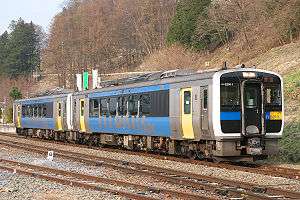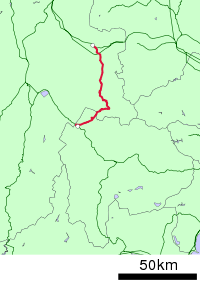Koumi Line
| Koumi Line | |||
|---|---|---|---|
|
JR East KiHa 110 series DMU on the Koumi Line | |||
| Overview | |||
| Type | Regional rail | ||
| Locale | Yamanashi, Nagano prefectures | ||
| Termini |
Kobuchizawa Komoro | ||
| Stations | 31 | ||
| Operation | |||
| Opened | 1919 | ||
| Owner | JR East | ||
| Rolling stock | KiHa E200, KiHa 110 series DMUs | ||
| Technical | |||
| Line length | 78.9 km (49.0 mi) | ||
| Track gauge | 1,067 mm (3 ft 6 in) | ||
| Electrification | None | ||
| |||
The Koumi Line (小海線 Koumi-sen) is a railway line in Japan operated by East Japan Railway Company (JR East). It links Kobuchizawa Station in Hokuto, Yamanashi with Komoro Station in Komoro, Nagano, and extends 78.9 km through the mountains with a total of 31 stations. It roughly follows the route of National Route 141, paralleling the road at some places and crossing it twice.
Stations
All trains stop at all stations.
Some of the stations along the Koumi Line are among the highest in Japan, with Nobeyama Station reaching 1,345 meters above sea level. Because of the frequent stops and winding route the full 78.9 kilometre journey often takes as long as two and a half hours to traverse, however the journey is well known for its beautiful scenery.
| Station | Japanese | Distance (km) | Transfers | Location | |||
|---|---|---|---|---|---|---|---|
| Between stations |
Total | ||||||
| Kobuchizawa | 小淵沢 | - | 0.0 | Chūō Main Line | ∨ | Hokuto | Yamanashi |
| Kai-Koizumi | 甲斐小泉 | 7.1 | 7.1 | ◇ | |||
| Kai-Ōizumi | 甲斐大泉 | 5.1 | 12.2 | ◇ | |||
| Kiyosato | 清里 | 5.3 | 17.5 | ◇ | |||
| Nobeyama | 野辺山 | 5.9 | 23.4 | ◇ | Minamimaki, Minamisaku District | Nagano | |
| Shinano-Kawakami | 信濃川上 | 8.1 | 31.5 | ◇ | Kawakami, Minamisaku | ||
| Saku-Hirose | 佐久広瀬 | 3.4 | 34.9 | | | Minamimaki, Minamisaku | ||
| Saku-Uminokuchi | 佐久海ノ口 | 4.8 | 39.7 | ◇ | |||
| Umijiri | 海尻 | 2.4 | 42.1 | | | |||
| Matsubarako | 松原湖 | 2.7 | 44.8 | | | Koumi, Minamisaku | ||
| Koumi | 小海 | 3.5 | 48.3 | ◇ | |||
| Managashi | 馬流 | 1.6 | 49.9 | | | |||
| Takaiwa | 高岩 | 1.8 | 51.7 | | | Sakuho, Minamisaku | ||
| Yachiho | 八千穂 | 2.2 | 53.9 | ◇ | |||
| Kaize | 海瀬 | 2.6 | 56.5 | | | |||
| Haguroshita | 羽黒下 | 1.3 | 57.8 | ◇ | |||
| Aonuma | 青沼 | 1.7 | 59.5 | | | Saku | ||
| Usuda | 臼田 | 1.4 | 60.9 | ◇ | |||
| Tatsuokajō | 龍岡城 | 1.2 | 62.1 | | | |||
| Ōtabe | 太田部 | 2.0 | 64.1 | | | |||
| Nakagomi | 中込 | 1.4 | 65.5 | ◇ | |||
| Namezu | 滑津 | 1.0 | 66.5 | | | |||
| Kita-Nakagomi | 北中込 | 1.9 | 68.4 | | | |||
| Iwamurada | 岩村田 | 2.2 | 70.6 | ◇ | |||
| Sakudaira | 佐久平 | 0.9 | 71.5 | Hokuriku Shinkansen | | | ||
| Nakasato | 中佐都 | 0.9 | 72.4 | | | |||
| Misato | 美里 | 1.4 | 73.8 | | | Komoro | ||
| Mitsuoka | 三岡 | 1.5 | 75.3 | ◇ | |||
| Otome | 乙女 | 1.1 | 76.4 | | | |||
| Higashi-Komoro | 東小諸 | 1.0 | 77.4 | | | |||
| Komoro | 小諸 | 1.5 | 78.9 | Shinano Railway Line | ∧ | ||
Legend
- ◇・∨・∧ - passing loop
- | - no passing loop
Rolling stock
- KiHa 110 series DMUs, since November 1991
- KiHa E200 hybrid DMUs, since July 2007
 A two-car KiHa 110 series train on the Koumi Line, April 2008
A two-car KiHa 110 series train on the Koumi Line, April 2008 A two-car KiHa E200 series train on the Koumi Line, April 2009
A two-car KiHa E200 series train on the Koumi Line, April 2009
Special liveries
In February 2015, to mark the 80th anniversary of the opening of the Koumi Line, a single-car KiHa 110 series unit was repainted into the "Metropolitan" all-over red livery carried by KiHa 52 DMUs formerly used on the line.[1] This was followed in March 2015 by a two-car KiHa 110 series unit repainted into the vermillion and cream livery carried by KiHa 58 series DMUs formerly used on the line.[1]
 Koumi Line KiHa 110-121 in "Metropolitan" all-over red livery, February 2015
Koumi Line KiHa 110-121 in "Metropolitan" all-over red livery, February 2015
History
The Saku Railway opened the section from Komoro to Haguroshita in 1915, and extended the line to Koumi in 1919. The company planned a railway network extending from Kōfu in the south to Naoetsu and Nagaoka in the north, linking up with the Fuji Minobe Railway to create a coast-to-coast rail line. North of Komoro, Saku Railway obtained a construction permit for a section between Yashiro and Suzaka, but this was transferred to the local Katō Railway (predecessor of the Nagano Electric Railway). Due to World War I construction of the line south of Koumi was not undertaken. Diesel railcars were introduced on the line in 1930.
The Koumi - Saku-Uminokuchi section was opened in 1932 by Japanese National Railways (JNR), which also opened the Kobuchizawa — Kiyosato section in 1933. The Saku Railway was nationalised in 1934, and the Saku-Uminokuchi - Kiyosato section opened in 1935, completing the line.
Timeline
- November 29, 1935: Nobeyama Station opens.
- March 1, 1944: Kubo Station renamed Kita-Nakagomi Station. Namezu Station closed.
- November 11, 1944: Operations stopped at Managashi, Irizawa, Ōnara, and Otome stations.
- March 1, 1952: Second Namezu Station opens. Operations resume at Managashi, Aonuma (formerly Irizawa), Tatsuokajō (formerly Ōnara), Otome stations.
- May 1, 1952: Ōtabe Station opens.
- July 10, 1952: Higashi-Komoro Station opens.
- October 1, 1959: Sakuhozumi Station renamed Yachiho Station.
- October 1, 1963: Sandanda Station renamed Usuda Station.
- February 1, 1984: Freight operations end.
- July 26, 1986: Photo Deck Station opens.[2]
- September 1, 1986: Photo Deck Station closes.
- April 1, 1987: With the privatization and breakup of JNR, line becomes part of East Japan Railway Company (JR East).
- December 1, 1988: Misato Station opens.
- November 8, 1991: KiHa 110 series DMUs begin operation.
- March 14, 1992: Driver-only operation begins.
- October 12, 1995: Iwamurada — Nakasato section elevated.
- October 1, 1997: Sakudaira Station opens.
- July 31, 2007: KiHa E200 series hybrid DMUs begin operation.
See also
References
This article incorporates material from the corresponding article in the Japanese Wikipedia
| Wikimedia Commons has media related to Koumi Line. |
- 1 2 小海線全線開通80周年記念でキハ110系塗色変更車 [KiHa 110 series trains to be repainted to mark 80th anniversary of Koumi Line opening]. Tetsudo Hobidas (in Japanese). Japan: Neko Publishing CO., Ltd. 27 February 2015. Retrieved 27 February 2015.
- ↑ 今井恵介監修『日本鉄道旅行地図 6号 北信越』新潮社、2008年、p.41


.svg.png)